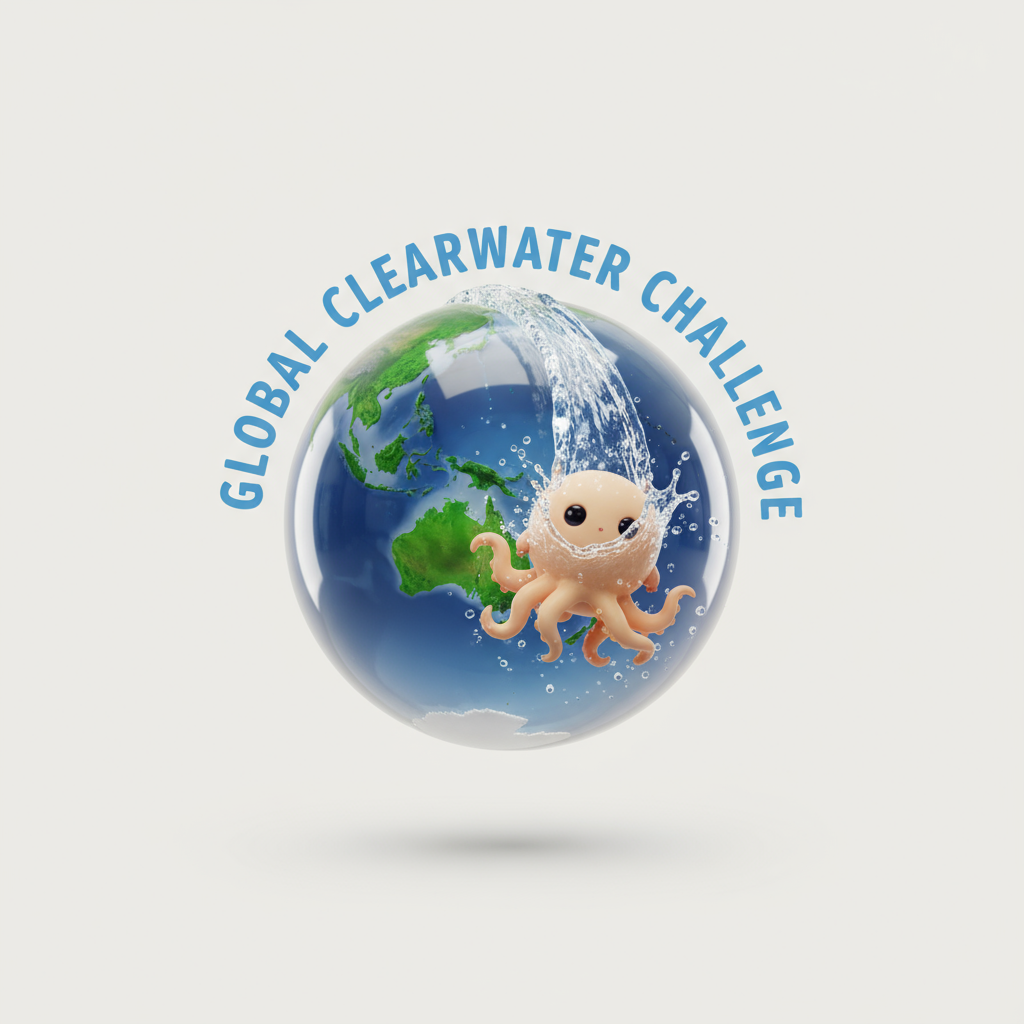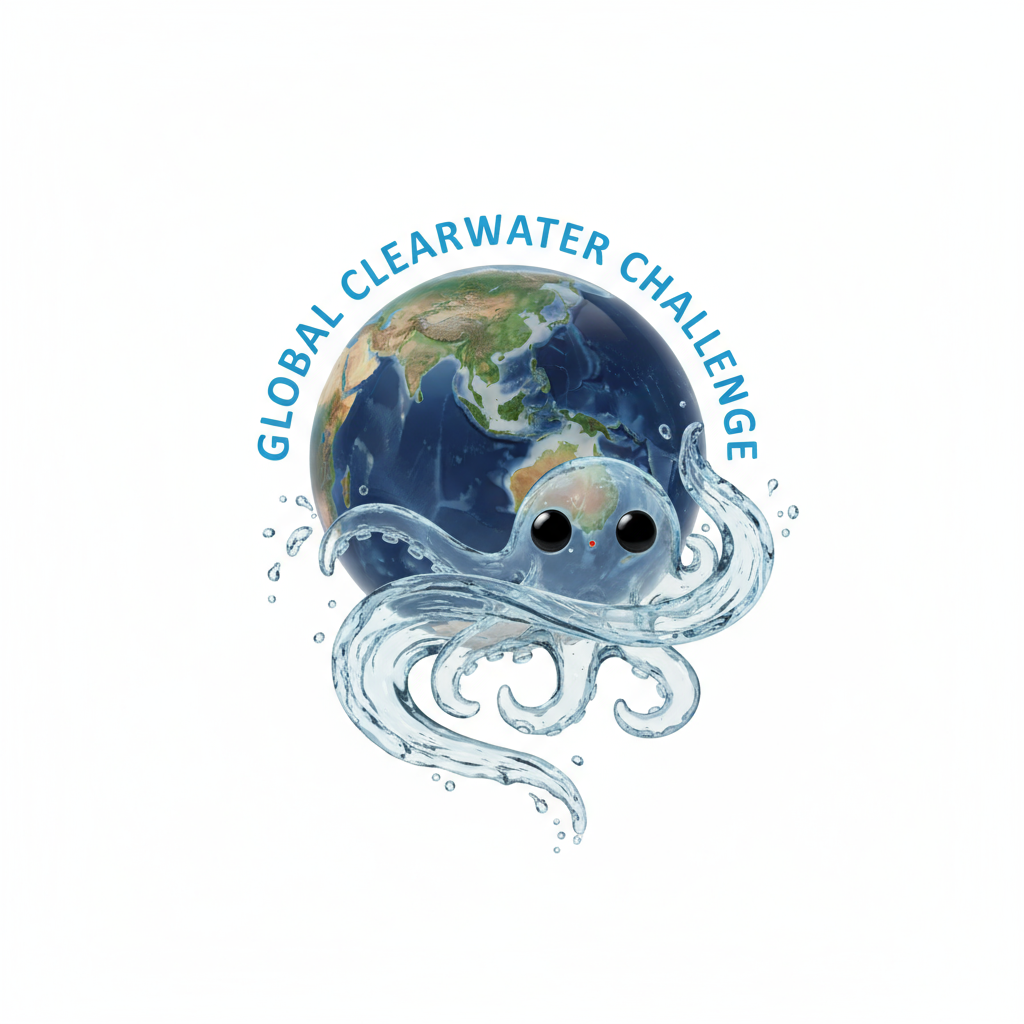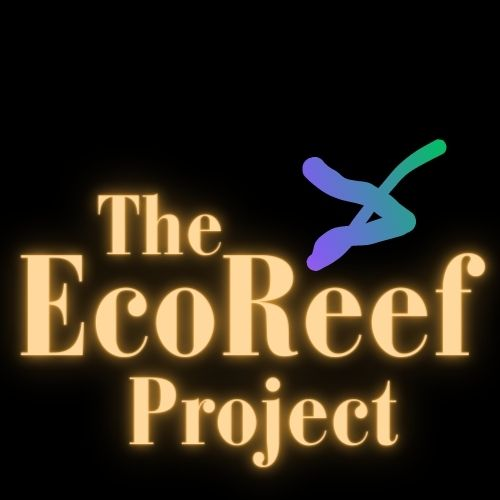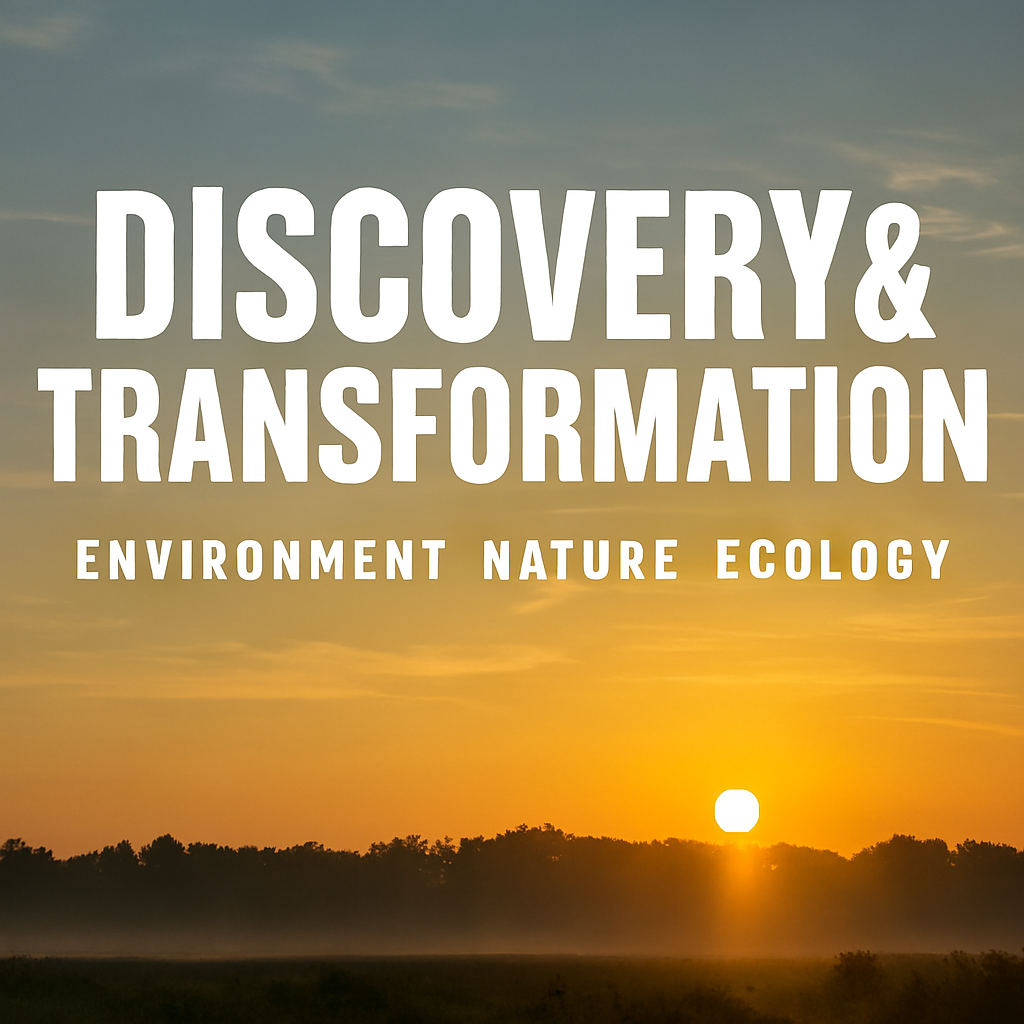Clean Water – Scientific Integrity Meets Restoration
The Clearwater Challenge – Editorial Ecology Meets Planetary Repair
The Global Clearwater Challenge reframes clean water as both a measurable condition and a symbolic restoration. It is not a contest for purity, but a participatory framework for ecological repair, cultural memory, and editorial storytelling. The challenge invites cities, schools, companies, and communities to restore their local waterways through modular actions — from drain audits to ritual planting. Participants begin at the source, tracing water from springs and storm drains to rivers and oceans.
Each act is documented, mapped, and shared through a global dashboard, turning local gestures into planetary coherence. Symbolic interventions — poems, murals, ceremonies — are treated as editorial annotations in the living manuscript of water. Infrastructure is reimagined as ecological syntax, with pipes, culverts, and runoff channels becoming narrative thresholds. Children are positioned not as future stewards but as present-day custodians, choreographing restoration through curriculum, play, and ritual. The challenge treats data as narrative, encouraging participants to publish metrics with clarity and emotional resonance. Every restored stream becomes a paragraph in the planetary archive, and every participant becomes a co-author of ecological transformation.
Clearwater Challenge Framework – Modular Restoration and Editorial Mapping
| Component | Function | Example Implementation |
|---|---|---|
| Source-to-Sea Mapping | Traces water from origin to outlet | School audits storm drains to creek |
| Symbolic Restoration | Adds cultural and emotional resonance | Riverbank poem, canal mural, ritual planting |
| Infrastructure as Ecology | Reframes built systems as habitat | Retrofitted culvert supports native species |
| Youth-Led Stewardship | Empowers children as restoration leaders | Student-led drain audits and zine publishing |
| Data as Narrative | Turns metrics into storytelling | Biodiversity logs visualized as editorial maps |
Clean Water on Purity, Participation, and Planetary Repair
Clean water is not just a chemical benchmark. It is a living condition shaped by ecological function, infrastructure, and cultural stewardship. Scientifically, clean water meets thresholds for turbidity, dissolved oxygen, pH, and microbial safety. Symbolically, it reflects care, memory, and community engagement. The Global Clearwater Challenge reframes clean water as both measurable and meaningful. It invites schools, councils, and communities to restore clarity from source to sea. Clean water becomes a shared goal, not just a technical achievement.
Turbidity Reduction – Measuring Clarity
Turbidity measures how much suspended material clouds the water. Clean water has low turbidity, allowing light to penetrate and photosynthesis to occur. Turbidity is measured in nephelometric turbidity units (NTU). Values below 5 NTU are considered safe for drinking and aquatic life. High turbidity can result from erosion, runoff, or algal blooms. The Clearwater Challenge encourages turbidity audits as part of stream assessments. Participants use EcoReef kits to measure and document clarity. Restoration actions include sediment control and vegetation planting. Turbidity reduction improves habitat and visibility. Clarity is both a metric and a metaphor.
Turbidity Standards and Restoration Actions
| Turbidity Level (NTU) | Water Quality Category | Recommended Action |
|---|---|---|
| 0–5 | Excellent | Maintain vegetation and buffer zones |
| 6–25 | Moderate | Audit runoff and stabilize banks |
| >25 | Poor | Remove sediment sources and replant edges |
Dissolved Oxygen – Supporting Respiration
Dissolved oxygen (DO) is essential for aquatic life. Clean water maintains DO above 5 mg/L. Oxygen levels fluctuate with temperature, flow, and biological activity. Low DO causes hypoxia and fish mortality. The Clearwater Challenge includes DO testing in its ecological toolkits. Participants measure oxygen levels and correlate them with restoration efforts. Vegetation, flow regulation, and shade improve oxygen retention. DO supports decomposition, nutrient cycling, and biodiversity. Oxygen is a signal of ecological function. Clean water breathes.
Dissolved Oxygen Metrics and Influences
| DO Level (mg/L) | Ecological Status | Restoration Strategy |
|---|---|---|
| >7 | Optimal | Preserve canopy and flow |
| 5–7 | Acceptable | Enhance vegetation and aeration |
| <5 | Critical | Remove organic overload and increase flow |
pH Balance – Chemical Stability
pH measures the acidity or alkalinity of water. Clean water typically ranges from pH 6.5 to 8.5. Extreme pH harms aquatic organisms and disrupts nutrient availability. Acidic water can result from mining, acid rain, or decaying vegetation. Alkaline water may stem from industrial discharge or carbonate-rich soils. The Clearwater Challenge includes pH testing as a core metric. Participants document pH trends and identify sources of imbalance. Restoration includes buffering zones and pollution control. pH balance supports biological and infrastructural stability. Clean water is chemically calm.
pH Ranges and Ecological Implications
| pH Range | Water Condition | Ecological Impact |
|---|---|---|
| 6.5–8.5 | Stable | Supports aquatic life and infrastructure |
| <6.5 | Acidic | Reduces biodiversity and increases corrosion |
| >8.5 | Alkaline | Alters nutrient cycling and species tolerance |
Microbial Safety – Pathogen-Free Water
Clean water contains no harmful pathogens. Common indicators include E. coli, coliforms, and Giardia. These microbes cause gastrointestinal illness and infection. Water is tested using culture methods and rapid assays. The Clearwater Challenge promotes microbial audits in schools and communities. Participants test local drains, creeks, and stormwater outlets. Restoration includes source control and disinfection strategies. Pathogen-free water supports recreation and public health. Microbial safety is invisible but essential. Clean water protects.

Microbial Indicators and Safety Thresholds
| Microbe | Safe Level (CFU/100 mL) | Health Risk |
|---|---|---|
| E. coli | 0 | Indicates fecal contamination |
| Total Coliforms | <1 | Signals microbial presence |
| Giardia | Not detectable | Causes intestinal illness |
Nutrient Control – Preventing Overload
Clean water contains nutrients in balanced concentrations. Nitrogen and phosphorus support plant growth but cause harm in excess. Elevated nutrients lead to eutrophication and algal blooms. The Clearwater Challenge includes nutrient testing and runoff audits. Participants identify sources like fertilizers, sewage, and stormwater. Restoration includes buffer planting and nutrient interception. Clean water maintains nitrogen below 1 mg/L and phosphorus below 0.1 mg/L. Nutrient control supports clarity and oxygenation. Fertility must be functional, not excessive.
Nutrient Thresholds and Restoration Tactics
| Nutrient | Safe Concentration | Restoration Method |
|---|---|---|
| Total Nitrogen | <1.0 mg/L | Reduce fertilizer use and plant buffers |
| Total Phosphorus | <0.1 mg/L | Intercept runoff and audit discharge |
| Ammonia | <0.02 mg/L | Remove organic waste and aerate systems |
Temperature Regulation – Thermal Stability for Life
Clean water maintains temperature ranges that support aquatic organisms. Thermal stability affects oxygen solubility, metabolic rates, and species distribution. Clean water avoids thermal pollution from urban runoff, deforestation, or industrial discharge. Ideal temperatures range from 10°C to 25°C for temperate freshwater systems. Sudden shifts can cause stress, migration disruption, or mortality. The Clearwater Challenge encourages canopy restoration to regulate temperature. Participants measure temperature using digital probes and shade audits. Vegetation buffers heat and stabilizes seasonal transitions. Thermal regulation supports biodiversity and oxygen retention. Clean water is thermally consistent.
Temperature Metrics and Restoration Actions
| Temperature Range | Ecological Status | Restoration Strategy |
|---|---|---|
| 10–20°C | Optimal | Preserve riparian canopy and flow |
| 21–25°C | Acceptable | Increase shading and reduce runoff |
| >25°C | Stressful | Audit heat sources and restore vegetation |
Metal Concentrations – Trace Elements with Boundaries
Clean water contains metals only in safe, trace concentrations. Heavy metals like lead, mercury, and cadmium are toxic even at low levels. These elements disrupt neurological, reproductive, and immune systems. Clean water maintains lead below 0.01 mg/L and mercury below 0.001 mg/L. The Clearwater Challenge includes metal testing in urban creeks and stormwater drains. Participants identify sources like corroded infrastructure and industrial runoff. Restoration includes pipe replacement, sediment removal, and source control. Metals must be monitored continuously to prevent bioaccumulation. Clean water is chemically safe. Purity includes elemental discipline.
Heavy Metal Thresholds and Mitigation
| Metal | Safe Concentration | Common Source |
|---|---|---|
| Lead (Pb) | < 0.01 mg/L | Plumbing corrosion, urban runoff |
| Mercury (Hg) | < 0.001 mg/L | Industrial discharge, landfill leachate |
| Cadmium (Cd) | < 0.003 mg/L | Mining waste, battery disposal |
Toxic Compounds – Absence of Synthetic Harm
Clean water is free from synthetic toxins and persistent pollutants. These include pesticides, hydrocarbons, solvents, and endocrine disruptors. Toxic compounds interfere with reproduction, immunity, and development. Clean water shows non-detectable levels of persistent organic pollutants (POPs). The Clearwater Challenge promotes chemical audits in agricultural and urban zones. Participants test for pesticide residues and hydrocarbon traces. Restoration includes runoff interception and organic land management. Toxins must be absent, not just diluted. Clean water is chemically clean. Purity excludes poison.
Toxic Compound Standards and Restoration
| Compound Type | Detection Threshold | Ecological Risk |
|---|---|---|
| Pesticides | < 0.01 µg/L | Hormonal disruption and reproductive harm |
| Hydrocarbons | Not detectable | Carcinogenic and mutagenic effects |
| Industrial Solvents | < 0.005 µg/L | Neurological and immune system damage |
Ecological Indicators – Life as a Measure
Clean water supports sensitive, diverse aquatic organisms. Indicator species include macroinvertebrates, fish, and algae. Their presence reflects stable oxygen, nutrients, and habitat. Clean water shows high biodiversity and low dominance by tolerant species. Biotic indices measure richness, abundance, and functional traits. The Clearwater Challenge includes biological surveys and species mapping. Participants identify mayflies, stoneflies, and caddisflies as signs of purity. Restoration includes habitat complexity and flow enhancement. Life reveals what chemistry cannot. Clean water is biologically vibrant.

Biological Indicators and Ecological Meaning
| Indicator Group | Presence in Clean Water | Ecological Interpretation |
|---|---|---|
| Mayflies | High abundance | Sensitive to pollution and low oxygen |
| Stoneflies | Require cold, oxygen-rich water | Indicate pristine conditions |
| Caddisflies | Build cases and filter particles | Reflect stable substrate and flow |
Flow Dynamics – Movement That Maintains Quality
Clean water flows in patterns that support oxygenation and sediment stability. Stagnant water promotes microbial growth and nutrient accumulation. Flow dynamics influence temperature, clarity, and habitat structure. Clean water shows moderate velocity and turbulence. The Clearwater Challenge includes flow mapping and velocity audits. Participants measure flow using float tests and digital meters. Restoration includes channel re-shaping and vegetation placement. Movement sustains purity and ecological function. Clean water is never still for long. Flow is structure in motion.
Flow Metrics and Restoration Techniques
| Flow Parameter | Ideal Range | Ecological Benefit |
|---|---|---|
| Velocity | 0.1–0.5 m/s (streams) | Supports oxygenation and sediment transport |
| Discharge | Stable seasonal variation | Prevents flooding and drought stress |
| Turbulence | Moderate mixing | Enhances gas exchange and clarity |
Infrastructure Design – Systems That Protect
Clean water depends on safe, resilient infrastructure. Pipes, tanks, and drains must resist corrosion and contamination. Materials include stainless steel, PVC, and concrete. Infrastructure must prevent backflow and cross-contamination. The Clearwater Challenge includes infrastructure audits and design workshops. Participants map stormwater paths and identify risks. Restoration includes pipe upgrades, wetland integration, and flow redirection. Infrastructure must align with ecological goals. Clean water flows through clean systems. Design is destiny.
Infrastructure Components and Risk Factors
| Component | Material | Risk if Compromised |
|---|---|---|
| Pipes | PVC, stainless steel | Lead leaching, microbial growth |
| Storage Tanks | Concrete, polyethylene | Algae blooms, sediment accumulation |
| Valves and Pumps | Corrosion-resistant alloys | Pressure loss, contamination |
Symbolic Zones – Mapping Meaning into Place
Clean water is not just a chemical condition — it is a symbolic landscape. The Clearwater Challenge encourages mapping zones of meaning. These include “source zones,” “filter zones,” and “story zones.” Participants identify where water begins, where it is cleaned, and where it is shared. Restoration includes signage, storytelling, and ritual planting. Symbolic zones connect ecological function to cultural memory. Clean water becomes a narrative, not just a measurement. Mapping meaning deepens stewardship. Water flows through stories. Purity is place-aware.
Symbolic Zone Types and Functions
| Zone Type | Ecological Role | Symbolic Function |
|---|---|---|
| Source Zone | Origin of flow | Anchors memory and upstream care |
| Filter Zone | Vegetation and sediment trap | Represents healing and transformation |
| Story Zone | Community access and signage | Invites reflection and participation |
Editorial Mapping – Publishing Water’s Journey
Clean water can be documented through editorial structure. The Clearwater Challenge encourages modular storytelling. Participants publish water audits, restoration logs, and visual maps. Editorial mapping includes headings, tables, and symbolic overlays. Each section reflects a stage in water’s journey. Restoration becomes a narrative with clarity and resonance. Publishing deepens engagement and accountability. Clean water is a story worth telling. Editorial structure mirrors ecological structure. Words restore water.
Editorial Elements for Water Documentation
| Element | Function | Example Use |
|---|---|---|
| Modular Headings | Organize stages | “Source Integrity,” “Flow Dynamics” |
| Tables | Present metrics | Turbidity levels, DO ranges |
| Symbolic Overlays | Add meaning | “Purity Engine,” “Liquid Signal” |
Community Engagement – Participation as Purity
Clean water is sustained through collective action. The Clearwater Challenge mobilizes schools, councils, and communities. Participants conduct audits, plant buffers, and share findings. Engagement builds ecological literacy and civic pride. Restoration becomes a shared ritual. Clean water reflects participation, not just policy. Community events include water walks, planting days, and storytelling sessions. Engagement is measured in action, not attendance. Clean water is a public achievement. Purity is participatory.
Community Actions and Impact Measures
| Action Type | Ecological Benefit | Social Outcome |
|---|---|---|
| Buffer Planting | Reduces runoff and erosion | Builds ownership and visibility |
| Water Audits | Tracks quality and flow | Informs local planning and education |
| Storytelling Events | Shares meaning and memory | Deepens connection and stewardship |
Youth Leadership – Generational Stewardship
Clean water is sustained when young people lead. The Clearwater Challenge centers youth as ecological architects. Students conduct audits, plant buffers, and publish findings. Leadership builds confidence, literacy, and civic identity. Young participants learn water chemistry, mapping, and restoration design. Schools become hubs of ecological action. Clean water becomes a generational legacy. Youth-led projects show higher engagement and retention. Leadership is measured in initiative, not age. Clean water flows through young hands.
Youth Actions and Educational Impact
| Activity | Ecological Benefit | Learning Outcome |
|---|---|---|
| Water Testing | Tracks quality and trends | Builds scientific literacy |
| Buffer Planting | Reduces runoff and erosion | Teaches systems thinking |
| Story Mapping | Connects place and meaning | Develops narrative and visual skills |
Ritual Restoration – Rebuilding Through Repetition
Clean water is restored through repeated, symbolic acts. The Clearwater Challenge encourages seasonal rituals like planting, cleaning, and storytelling. Ritual builds memory, rhythm, and emotional connection. Restoration becomes a practice, not a project. Participants return to the same sites across seasons. They observe change, document progress, and adapt strategies. Ritual deepens commitment and ecological intimacy. Clean water is not fixed once — it is tended. Repetition creates resilience. Restoration is ritualized care.
Ritual Elements and Ecological Function
| Ritual Type | Frequency | Ecological Role |
|---|---|---|
| Seasonal Planting | Quarterly | Stabilizes soil and intercepts runoff |
| Water Walks | Monthly | Monitors flow and builds awareness |
| Story Circles | Annual | Shares memory and builds community |
Data Storytelling – Turning Metrics into Meaning
Clean water is documented through data and narrative. The Clearwater Challenge teaches participants to publish findings with clarity and resonance. Data storytelling includes tables, maps, and symbolic overlays. Each metric becomes part of a larger ecological arc. Participants learn to interpret turbidity, DO, and pH in context. Restoration logs become editorial modules. Stories are shared across schools, councils, and global platforms. Data becomes dialogue. Clean water is not just measured — it is narrated. Metrics become meaning.

Data Elements and Story Formats
| Data Type | Story Format | Audience Engagement |
|---|---|---|
| Turbidity Logs | Tables and graphs | Visual clarity and comparison |
| Species Maps | Illustrated overlays | Connects biodiversity to place |
| Restoration Journals | Modular editorial posts | Builds continuity and emotional resonance |
Outreach as Art – Communicating Through Creativity
Clean water can be communicated through artistic media. The Clearwater Challenge includes visual, musical, and performative outreach. Participants design posters, murals, and installations. Art translates science into emotion and accessibility. Outreach builds visibility and cultural relevance. Clean water becomes a public conversation. Artistic formats include zines, spoken word, and symbolic signage. Creativity invites diverse participation. Outreach is measured in impact, not scale. Clean water is expressed as art.
Artistic Outreach Formats and Functions
| Format | Communication Role | Ecological Message |
|---|---|---|
| Murals | Public visibility | Celebrates local water systems |
| Spoken Word | Emotional resonance | Shares restoration stories |
| Editorial Zines | Portable education | Combines data and narrative |
Global Coherence – Connecting Local to Planetary
Clean water is a global concern with local roots. The Clearwater Challenge links schools and communities across continents. Participants share methods, findings, and symbolic frameworks. Global coherence builds solidarity and adaptive learning. Restoration becomes a planetary ritual. Local actions reflect global patterns of pollution, drought, and resilience. Clean water is a shared language. The challenge fosters cross-cultural exchange and ecological equity. Coherence is built through modular formats and shared metrics. Water connects the world.
Global Participation and Shared Metrics
| Region | Common Challenge | Shared Metric |
|---|---|---|
| Australia | Urban runoff and drought | Turbidity and canopy cover |
| Southeast Asia | Agricultural nutrient overload | Nitrogen and phosphorus levels |
| North America | Infrastructure aging | Metal concentrations and microbial safety |
Conclusion – Clean Water as Structure, Story, and Stewardship
Clean water is not just a technical condition — it is a structured system, a symbolic story, and a shared responsibility. It reflects upstream integrity, ecological design, and community participation. The Global Clearwater Challenge reframes purity as both measurable and meaningful. It invites schools, councils, and creatives to restore clarity from source to sea. Clean water is documented through metrics, mapped through editorial structure, and expressed through art. It is sustained through ritual, youth leadership, and global coherence. lean water is clarity with consequence. It is the signal of a system that remembers how to heal.
Join the Discussion – What Does Clarity Mean Where You Are
How do you define clean water in your local system — chemically, ecologically, or symbolically? Which metrics do you trust most when restoring clarity: turbidity, dissolved oxygen, or biodiversity? What rituals, audits, or stories have helped you reconnect with your waterway? How does the Clearwater Challenge reshape your understanding of purity, participation, and place? What would a map of your water’s memory look like — and who would help you draw it?
#ClearwaterChallenge #CleanWaterDefined #WaterLiteracy #SourceToStory #MeasuredClarity #SymbolicRestoration #YouthStewardship #TurbidityAudit #FlowMapping #EcologicalIndicators #WaterAsStructure #GlobalWaterSolidarity #EditorialEcology #RitualRestoration #LiquidMemory









Leave a Reply